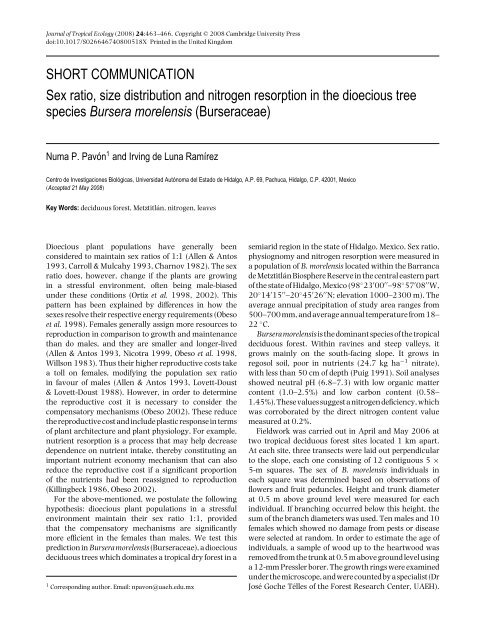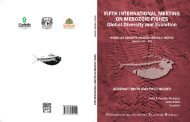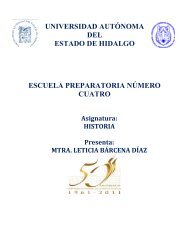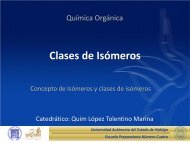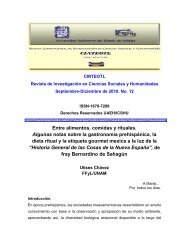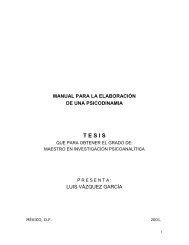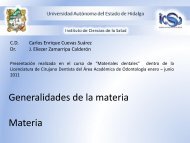Bursera morelensis - Universidad Autónoma del Estado de Hidalgo
Bursera morelensis - Universidad Autónoma del Estado de Hidalgo
Bursera morelensis - Universidad Autónoma del Estado de Hidalgo
Create successful ePaper yourself
Turn your PDF publications into a flip-book with our unique Google optimized e-Paper software.
Journal of Tropical Ecology (2008) 24:463–466. Copyright © 2008 Cambridge University Press<br />
doi:10.1017/S026646740800518X Printed in the United Kingdom<br />
SHORT COMMUNICATION<br />
Sex ratio, size distribution and nitrogen resorption in the dioecious tree<br />
species <strong>Bursera</strong> <strong>morelensis</strong> (<strong>Bursera</strong>ceae)<br />
Numa P. Pavón 1 and Irving <strong>de</strong> Luna Ramírez<br />
Centro <strong>de</strong> Investigaciones Biológicas, <strong>Universidad</strong> <strong>Autónoma</strong> <strong><strong>de</strong>l</strong> <strong>Estado</strong> <strong>de</strong> <strong>Hidalgo</strong>, A.P. 69, Pachuca, <strong>Hidalgo</strong>, C.P. 42001, Mexico<br />
(Accepted 21 May 2008)<br />
Key Words: <strong>de</strong>ciduous forest, Metztitlán, nitrogen, leaves<br />
Dioecious plant populations have generally been<br />
consi<strong>de</strong>red to maintain sex ratios of 1:1 (Allen & Antos<br />
1993, Carroll & Mulcahy 1993, Charnov 1982). The sex<br />
ratio does, however, change if the plants are growing<br />
in a stressful environment, often being male-biased<br />
un<strong>de</strong>r these conditions (Ortiz et al. 1998, 2002). This<br />
pattern has been explained by differences in how the<br />
sexes resolve their respective energy requirements (Obeso<br />
et al. 1998). Females generally assign more resources to<br />
reproduction in comparison to growth and maintenance<br />
than do males, and they are smaller and longer-lived<br />
(Allen & Antos 1993, Nicotra 1999, Obeso et al. 1998,<br />
Willson 1983). Thus their higher reproductive costs take<br />
a toll on females, modifying the population sex ratio<br />
in favour of males (Allen & Antos 1993, Lovett-Doust<br />
& Lovett-Doust 1988). However, in or<strong>de</strong>r to <strong>de</strong>termine<br />
the reproductive cost it is necessary to consi<strong>de</strong>r the<br />
compensatory mechanisms (Obeso 2002). These reduce<br />
the reproductive cost and inclu<strong>de</strong> plastic response in terms<br />
of plant architecture and plant physiology. For example,<br />
nutrient resorption is a process that may help <strong>de</strong>crease<br />
<strong>de</strong>pen<strong>de</strong>nce on nutrient intake, thereby constituting an<br />
important nutrient economy mechanism that can also<br />
reduce the reproductive cost if a significant proportion<br />
of the nutrients had been reassigned to reproduction<br />
(Killingbeck 1986, Obeso 2002).<br />
For the above-mentioned, we postulate the following<br />
hypothesis: dioecious plant populations in a stressful<br />
environment maintain their sex ratio 1:1, provi<strong>de</strong>d<br />
that the compensatory mechanisms are significantly<br />
more efficient in the females than males. We test this<br />
prediction in <strong>Bursera</strong> <strong>morelensis</strong> (<strong>Bursera</strong>ceae), a dioecious<br />
<strong>de</strong>ciduous trees which dominates a tropical dry forest in a<br />
1 Corresponding author. Email: npavon@uaeh.edu.mx<br />
semiarid region in the state of <strong>Hidalgo</strong>, Mexico. Sex ratio,<br />
physiognomy and nitrogen resorption were measured in<br />
a population of B. <strong>morelensis</strong> located within the Barranca<br />
<strong>de</strong> Metztitlán Biosphere Reserve in the central eastern part<br />
of the state of <strong>Hidalgo</strong>, Mexico (98 ◦ 23 ′ 00 ′′ –98 ◦ 57 ′ 08 ′′ W,<br />
20 ◦ 14 ′ 15 ′′ –20 ◦ 45 ′ 26 ′′ N; elevation 1000–2300 m). The<br />
average annual precipitation of study area ranges from<br />
500–700 mm, and average annual temperature from 18–<br />
22 ◦ C.<br />
<strong>Bursera</strong><strong>morelensis</strong>isthedominantspeciesofthetropical<br />
<strong>de</strong>ciduous forest. Within ravines and steep valleys, it<br />
grows mainly on the south-facing slope. It grows in<br />
regosol soil, poor in nutrients (24.7 kg ha −1 nitrate),<br />
with less than 50 cm of <strong>de</strong>pth (Puig 1991). Soil analyses<br />
showed neutral pH (6.8–7.3) with low organic matter<br />
content (1.0–2.5%) and low carbon content (0.58–<br />
1.45%).Thesevaluessuggestanitrogen<strong>de</strong>ficiency,which<br />
was corroborated by the direct nitrogen content value<br />
measured at 0.2%.<br />
Fieldwork was carried out in April and May 2006 at<br />
two tropical <strong>de</strong>ciduous forest sites located 1 km apart.<br />
At each site, three transects were laid out perpendicular<br />
to the slope, each one consisting of 12 contiguous 5 ×<br />
5-m squares. The sex of B. <strong>morelensis</strong> individuals in<br />
each square was <strong>de</strong>termined based on observations of<br />
flowers and fruit peduncles. Height and trunk diameter<br />
at 0.5 m above ground level were measured for each<br />
individual. If branching occurred below this height, the<br />
sum of the branch diameters was used. Ten males and 10<br />
females which showed no damage from pests or disease<br />
were selected at random. In or<strong>de</strong>r to estimate the age of<br />
individuals, a sample of wood up to the heartwood was<br />
removed from the trunk at 0.5 m above ground level using<br />
a 12-mm Pressler borer. The growth rings were examined<br />
un<strong>de</strong>rthemicroscope,andwerecountedbyaspecialist(Dr<br />
José GocheTélles of the Forest Research Center, UAEH).
464 NUMA P. PAVÓN AND IRVING DE LUNA RAMÍREZ<br />
In or<strong>de</strong>r to measure leaf nitrogen concentration, samples<br />
of leaves were taken from each selected individual during<br />
2006 (July, September, October and December) and 2007<br />
(September and November). Each sample consisted of<br />
leaves picked from different heights in the tree canopies.<br />
In July 2006 and September 2007, the leaves were<br />
green, while by October–November they had turned red.<br />
By the first week of December 2006 trees had partly<br />
<strong>de</strong>foliated, and only reddish-brown leaves showing signs<br />
of abscission were collected. In November 2007, leaves<br />
of selected trees showed signs of abscission, and were<br />
beginning to change to reddish yellow, although the<br />
colour of the sampled leaves was not homogeneous.<br />
In December the trees had <strong>de</strong>foliated completely. The<br />
samples were dried at 80 ◦ C for 4 d. They were then<br />
ground and the pow<strong>de</strong>r analysed for total nitrogen using<br />
a PerkinElmer 2400 CHNS/O Elemental Analyser.<br />
The chi-square test was used to <strong>de</strong>termine whether<br />
the proportion of males and females was significantly<br />
different from the expected proportion of 1:1. Differences<br />
intrunkdiameterandheightbetweensexeswereanalysed<br />
by t-tests. The data were transformed before analysis by<br />
taking the natural logarithm in or<strong>de</strong>r to meet assumptions<br />
of normality and homogeneity of variance assumptions<br />
(Zar 1999). The relationship between number of growth<br />
rings, and height and trunk base diameter was analysed<br />
using the Pearson correlation with the Bonferroni<br />
correction.<br />
For the 2006 data, total N concentration in the<br />
leaves was analysed by sampling date and by sex using<br />
an analysis of variance with repeated measures. The<br />
differences in nitrogen values between senescent leaves<br />
sampled in December 2006 and November 2007 was<br />
tested by the t-test (Zar 1999). Resorption efficiency<br />
(RE) was calculated using the equation proposed by<br />
Killingbeck & Costigan (1988):<br />
RE(%) = [(Nmature leaves − Nsenescent leaves)/<br />
(Nmature leaves)] × 100.<br />
Nitrogen concentration in mature leaves collected in<br />
late July was used to estimate 2006 RE, as values<br />
were highest in July. Concentrations were lowest in<br />
senescent leaves from November. For 2007, nitrogen<br />
concentrations were obtained from mature September<br />
leaves and senescent November leaves. Per cent RE values<br />
were standardized using an arcsine transformation, and<br />
differences between sexes and years were tested by a twoway<br />
analysis of variance (Zar 1999). All analyses were<br />
carried out using the Systat 12 statistical package.<br />
At neither study site did the number of males and<br />
females significantly different from 1:1 (χ 2 = 0.01, P <<br />
0.05 for site 1; χ 2 = 0.6, P < 0.05 for site 2). For<br />
the remain<strong>de</strong>r of the analysis, data from both sites were<br />
therefore pooled. The B. <strong>morelensis</strong> population maintains<br />
a sex ratio of 1:1 (χ 2 = 0.376, P = 0.47) as would be<br />
expected un<strong>de</strong>r the influence of natural selection and<br />
the absence of environmental variation (Allen & Antos<br />
1993, Carroll & Mulcahy 1993, Charnov 1982). Many<br />
studies show that this proportion is actually rare due to<br />
the influence of a variety of environmental factors on<br />
survival of females (Allen & Antos 1993, Bierzychu<strong>de</strong>k<br />
& Eckhart 1988, Cipollini & Stiles 1991, Dawson &<br />
Ehleringer 1993, Vasiliauskas & Aarssen 1992). This<br />
suggests that B. <strong>morelensis</strong> is adapted to the conditions<br />
of scarce precipitation and soil nutrient <strong>de</strong>ficit that are<br />
typical of the regions where it grows.<br />
Onaverage,malesweresignificantlytallerthanfemales<br />
(t=3.02,P=0.003).Therewasnosignificantcorrelation<br />
between height and the number of growth rings in either<br />
sex (r = 0.36 and r = 0.51, for males and females<br />
respectively), so age of individuals cannot be consi<strong>de</strong>red<br />
to account for differences in height. In both sexes, trunk<br />
diameter was significantly correlated with the number<br />
of growth rings (r = 0.94, P < 0.05 in females; r =<br />
0.86, P = 0.003 in males), but trunk diameter did<br />
not differ significantly by sex (t = 0.721, P = 0.472).<br />
The lower heights of female individuals as reported<br />
here cannot be consi<strong>de</strong>red a factor that would cause a<br />
survival disadvantage; rather they may be due to the<br />
fact that females of dioecious species generally assign<br />
proportionately more of their resources to reproduction<br />
than to growth and maintenance when compared to<br />
males (Obeso 2002, Obeso et al. 1998, Willson 1983).<br />
Females have been reported to grow more slowly than<br />
males for some dioecious species, perhaps as a result of the<br />
greater toll reproduction takes on females (Obeso 1997).<br />
The N concentration of the leaves was significantly<br />
different for 2006 sampling dates (F = 195, P < 0.001)<br />
(Figure 1). For females no significant differences were<br />
found between values for senescent leaves from December<br />
2006 and November 2007 (t = 1.19, P = 0.19) (Figure 1).<br />
Average RE was 82.4% ± 0.642% for 2006 and 53.2% ±<br />
6.05% for 2007, a significant difference (F = 23.6, P <<br />
0.01).In2006,thehighestnitrogenconcentrationvalues<br />
for the year were recor<strong>de</strong>d in July. In 2007, it was not<br />
possible to take a sample in that month, for that reason<br />
we used September values to estimate 2007 RE. It is<br />
possible that June or July of 2007 had the highest values of<br />
nitrogen concentration in that year and RE of 2007 could<br />
have been as high as that of 2006. On the other hand,<br />
in tropical <strong>de</strong>ciduous forests and arid tropical scrub, RE<br />
may vary consi<strong>de</strong>rably from year to year according to<br />
the availability of water (Pavón et al. 2005, Rentería et<br />
al. 2005). The values obtained in this study could reflect<br />
that RE had an inverse relationship with rainfall. The<br />
lowest value in RE was obtained in 2007, that year was<br />
extraordinarily wet with a precipitation of 693.8 mm,<br />
while in 2006 was 457.3 mm.
Sex ratios in dioecious tree species 465<br />
Figure 1 Foliar nitrogen percentage (average ± SE) of mature leaves of female and male individuals of <strong>Bursera</strong> <strong>morelensis</strong> during two growth season<br />
(2006 and 2007) in a <strong>de</strong>ciduous tropical forest in central Mexico.<br />
Nitrogen resorption efficiency in the population of B.<br />
<strong>morelensis</strong> was found to be between 53.2% and 82.4%,<br />
higher values than the average of 50% reported in the<br />
review by Aerts (1996). In other tropical <strong>de</strong>ciduous forest<br />
species, RE is less than 60% (Rentería et al. 2005). In<br />
these ecosystems, lower RE values have been reported<br />
in nitrogen-fixing trees such as Lysiloma microphyllum,<br />
where RE ranged from 16% to 42% (Car<strong>de</strong>nas & Campo<br />
2007). In another ecosystem, tropical montane rain<br />
forest, un<strong>de</strong>r more favourable environmental conditions,<br />
RE values are lower; the average RE of 14 tree species<br />
was 49.2% and the maximum was 71.5% for Alseodaphne<br />
petiolaris (Cai & Bongers 2007).<br />
Females of B. <strong>morelensis</strong> had significantly higher RE<br />
values for both years (F = 6.19, P = 0.018). In 2006,<br />
RE for females was 84.0% ± 0.65% and 80.8% ± 0.8%<br />
for males, whereas in 2007 females were 67.9% ± 5.4%<br />
and 40.0% ± 9.6% for males. Although, the interaction<br />
was not significant (F = 4.00, P = 0.06), the difference<br />
between sexes was more evi<strong>de</strong>nt in 2007. These results<br />
support the hypothesis that dioecious plant population<br />
in a stressful environment maintain their sex ratio<br />
1:1, provi<strong>de</strong>d that the compensatory mechanisms are<br />
significantly more efficient in the females than males. It is<br />
likely that greater resorption efficiency compensates part<br />
of the greater reproductive cost in females in comparison<br />
with males (Obeso 2002). The absence of an estimate of<br />
reproductive costs in B. <strong>morelensis</strong> limits us in <strong>de</strong>fining the<br />
biological importance of a minimum difference between<br />
sexes in the efficiency of nitrogen resorption (3%),<br />
as a compensatory mechanism for reproductive costs.<br />
However, it is likely that other compensatory mechanisms<br />
(Obeso 2002) are working simultaneously and as a whole<br />
they could compensate the higher reproductive costs in<br />
females. A similar result was reported for other dioecious<br />
species growing in high-quality environments (e.g. <strong>de</strong>ep,<br />
well-drained soils), as they can readily maintain a<br />
balancebetweenenergyresourcestakeninandconsumed<br />
in such areas (Dawson & Ehleringer 1993, Freeman<br />
et al. 1993, Ramadan et al. 1994). However, in stressful<br />
environments this pattern is scarcely known, but our<br />
results suggest that it could happen at <strong>Bursera</strong> <strong>morelensis</strong><br />
insi<strong>de</strong> the study area.<br />
ACKNOWLEDGEMENTS<br />
The manuscript was improved by the helpful comments of<br />
Raul Ortiz-Pulido. We thank José Rodolfo Goche Télles for<br />
the growth-ring analysis, Yolanda Marmolejo Santillán<br />
for the chemical analysis and Margaret Schroe<strong>de</strong>r for<br />
English revision. This paper was fun<strong>de</strong>d by <strong>Universidad</strong><br />
<strong>Autónoma</strong> <strong><strong>de</strong>l</strong> <strong>Estado</strong> <strong>de</strong> <strong>Hidalgo</strong> (PAI 06/02).<br />
LITERATURE CITED<br />
AERTS, R. 1996. Nutrient resorption from senescing leaves of perennials:<br />
are there general patterns? Journal of Ecology 84:597–608.<br />
ALLEN, G. A. & ANTOS, J. A. 1993. Sex ratio variation in the dioecious<br />
shrub Oemleria cerasiformis. American Naturalist 141:537–553.<br />
BIERZYCHUDEK, P. & ECKHART, V. 1988. Spatial segregation of the<br />
sexes of dioecious plants. American Naturalist 132:34–43.<br />
CAI, Z. & BONGERS, F. 2007. Contrasting nitrogen and phosphorus<br />
resorption efficiencies in trees and lianas from a tropical montane<br />
rain forest in Xishuangbanna, south-west China. Journal of Tropical<br />
Ecology 23:11–18.<br />
CARDENAS, I. & CAMPO, J. 2007. Foliar nitrogen and phosphorus<br />
resorption and <strong>de</strong>composition in the nitrogen-fixing tree Lysiloma<br />
microphylluminprimaryandsecondaryseasonallytropicaldryforests<br />
in Mexico. Journal of Tropical Ecology 23:10–13.<br />
CARROLL, S. B. & MULCAHY, D. L. 1993. Progeny sex ratio in dioecious<br />
Silene latifolia (Caryophyllaceae). American Journal of Botany 80:55–<br />
56.<br />
CHARNOV, E. L. 1982. The theory of sex allocation. Princeton University<br />
Press, Princeton. 355 pp.<br />
CIPOLLINI, M. L. & STILES, E. W. 1991. Costs of reproduction in Nyssa<br />
sylvatica: sexual dimorphism in reproductive frequency and nutrient<br />
flux. Oecologia 86:585–593.
466 NUMA P. PAVÓN AND IRVING DE LUNA RAMÍREZ<br />
DAWSON, T. E. & EHLERINGER, J. R. 1993. Gen<strong>de</strong>r-specific physiology,<br />
carbon isotope discrimination, and habitat distribution in boxel<strong>de</strong>r,<br />
Acer negundo. Ecology 74:798–815.<br />
FREEMAN, D. C., MCARTHUR, E. D., SANDERSON, S. C. &<br />
TIEDEMAN, A. R. 1993. The influence of topography on male and<br />
female fitness components of Atriplex canescens. Oecologia 93:538–<br />
547.<br />
KILLINGBECK, K. T. 1986. The terminological jungle revisited:<br />
making a case for use of the term resorption. Oikos 42:263–<br />
264.<br />
KILLINGBECK, K. T. & COSTIGAN, S. A. 1988. Element resorption in a<br />
guild of un<strong>de</strong>rstory shrub species: niche differentiation and resorption<br />
thresholds. Oikos 53:366–374.<br />
LOVETT-DOUST, J. & LOVETT-DOUST, L. 1988. Modules of production<br />
and reproduction in a dioecious clonal shrub, Rhus typhina. Ecology<br />
69:741–750.<br />
NICOTRA, A. B. 1999. Reproductive allocation and the long-term costs<br />
ofreproductioninSiparunagrandiflora,adioeciousneo-tropicalshrub.<br />
Journal of Ecology 87:138–149.<br />
OBESO, J. R. 1997. Costs of reproduction in Ilex aquifolium: effects at tree,<br />
branch and leaf level. Journal of Ecology 85:159–166.<br />
OBESO, J. R. 2002. The costs of reproduction in plants. New Phytologist<br />
155:32–48.<br />
OBESO, J. R., ALVAREZ-SANTULLANO, M. & RETUERTO, R. 1998. Sex<br />
ratios, size distributions, and sexual dimorphism in the dioecious tree<br />
Ilex aquifolium (Aquifoliaceae). American Journal of Botany 85:1602–<br />
1608.<br />
ORTIZ, P. L., ARISTA, M. & TALAVERA, S. 1998. Low reproductive<br />
success in two subspecies of Juniperus oxycedrus L. International Journal<br />
of Plant Sciences 159:843–847.<br />
ORTIZ, P. L., ARISTA, M. & TALAVERA, S. 2002. Sex ratio and<br />
reproductive effort in the dioecious Juniperus communis subsp. alpina<br />
(Suter) Celak. (Cupressaceae) along an altitudinal gradient. Annals of<br />
Botany 89:205–211.<br />
PAVÓN, N. P., BRIONES, O. & FLORES-RIVAS, J. 2005. Litterfall<br />
production and nitrogen content in an intertropical semi-arid<br />
Mexican scrub. Journal of Arid Environments 60:1–13.<br />
PUIG, H. 1991. Vegetación <strong>de</strong> la Huasteca Mexico: estudio fitogeográfico<br />
y ecológico. ORSTOM, Instituto <strong>de</strong> Ecología, CEMCA, Mexico City.<br />
625 pp.<br />
RAMADAN, A. A., EL-KEBLAWY, A., SHALTOUT, K. H. & LOVETT-<br />
DOUST, J. 1994. Sexual polymorphism, growth, and reproductive<br />
effort in Egyptian Thymelaea hirsuta (Thymelaeaceae). American<br />
Journal of Botany 81:847–857.<br />
RENTERÍA, L. Y., JARAMILLO, V. J., MARTÍNEZ-YRIZAR, A. & PÉREZ-<br />
JIMÉNEZ, A. 2005. Nitrogen and phosphorus resorption in trees of a<br />
Mexican tropical dry forest. Trees 19:431–441.<br />
VASILIAUSKAS, S. A. & AARSSEN, L. W. 1992. Sex ratio and neighbor<br />
effects in monospecific stands of Juniperus virginiana. Ecology 73:622–<br />
632.<br />
WILLSON, M. F. 1983. Plant reproductive ecology. Wiley, New York.<br />
282 pp.<br />
ZAR, J. H. 1999. Biostatistical analysis. Prentice Hall, New Jersey.<br />
663 pp.


